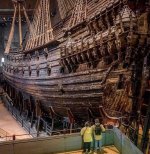- Jul 27, 2006
- 48,584
- 55,244
- Detector(s) used
- Minelab_Equinox_ 800 Minelab_CTX-3030 Minelab_Excal_1000 Minelab_Sovereign_GT Minelab_Safari Minelab_ETrac Whites_Beach_Hunter_ID Fisher_1235_X
- Primary Interest:
- All Treasure Hunting
The Vasa ship capsized and sank in Stockholm 1628. After over 330 years on the sea bed the warship was salvaged and the Vasa Museum built around the only completely intact and best preserved 17th century ships in existence

The Vasa Museum (vasamuseet.se)

The Vasa Museum (vasamuseet.se)
Amazon Forum Fav 👍
Last edited:




